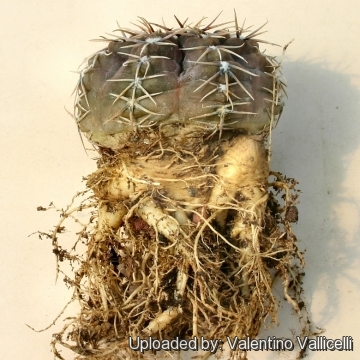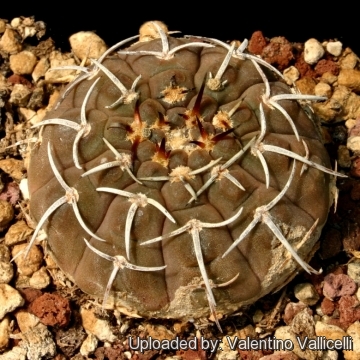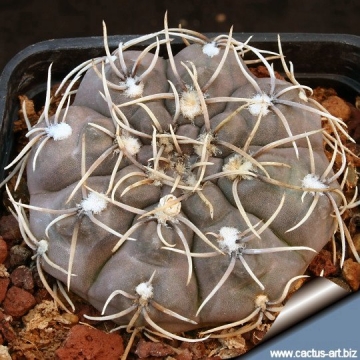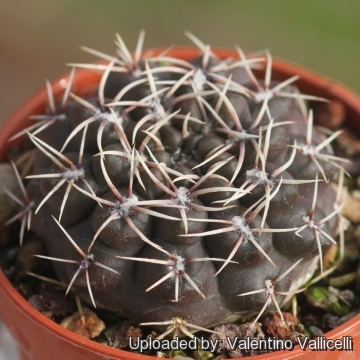Accepted Scientific Name: Gymnocalycium kieslingii O.Ferrari
Cact. Succ. J. (Los Angeles) 57(6): 244, fig. 1985

Gymnocalycium kieslingii f. castaneum Photo by: Valentino Vallicelli
VS50 Anillaco. Dark reddish-brown body and robust.
Origin and Habitat: Gymnocalycium kieslingiiSN|21441]]SN|21441]] f. castaneum is endemic to Argentina, where it occurs in La Rioja (Department Sanagasta, a few km north of Villa Sanagasta).
Altitude: 1000- 1600 metres above sea level.
Habitat and Ecology: The species grows in shrubland on hilly terrain, mountain foothills, on gentle slopes of crumbling granite usually under bushes. Gymnocalycium kieslingiiSN|21441]]SN|21441]] has a relatively wide range, it is abundant, and there are no major threats.
Synonyms:
See all synonyms of Gymnocalycium kieslingii
back
Accepted name in llifle Database:Gymnocalycium kieslingii O.FerrariCact. Succ. J. (Los Angeles) 57(6): 244, fig. 1985Synonymy: 6
back
Description: Gymnocalycium kieslingiiSN|21441]]SN|21441]] f. castaneum (Occasionally misspelled “castanea”) is a local or morphological form of Gymnocalycium kieslingiiSN|21441]]SN|21441]] characterized by a distingushing chestnut brown colour. Moreover it possesses less conspicuous chin humps.
Habit: This is a geophytes plant with a swollen underground root system.
Root: Large taproots.
Stem: Fattened to depressed globose, greenish to red-violet-brown, up to 2 cm high, 6-9 cm in diameter.
Ribs: 9-13, usually 12, low, rounded, with tubercles separated by distinct furrows. The castaneum form has less significant chin humps below the areoles.
Spines: The spines are pale brown to pastel and have a dark base.
Areoles: Large, woolly and peculiar.
Flowers: From young areoles near the apex, funnelform, 70 mm in length and 60 mm in diameter
Blooming season: The flowers appear recurrently from June to autumn.
Subspecies, varieties, forms and cultivars of plants belonging to the Gymnocalycium kieslingii group
Bibliography: Major references and further lectures
1) Edward Anderson “The Cactus family” Timber Press, Incorporated, 2001
2) David R Hunt; Nigel P Taylor; Graham Charles; International Cactaceae Systematics Group. "The New Cactus Lexicon" dh books, 2006
3) James Cullen, Sabina G. Knees, H. Suzanne Cubey "The European Garden Flora Flowering Plants: A Manual for the Identification of Plants Cultivated in Europe, Both Out-of-Doors and Under Glass" Cambridge University Press, 11/Aug/2011
4) Demaio, P., Perea, M. & Trevisson, M. 2013. Gymnocalycium kieslingii. In: IUCN 2013. "IUCN Red List of Threatened Species." Version 2013.2. <www.iucnredlist.org>. Downloaded on 06 January 2014.
 Gymnocalycium kieslingii f. castaneum Photo by: Valentino Vallicelli
Gymnocalycium kieslingii f. castaneum Photo by: Valentino Vallicelli P220 Locality: Sanagasta, La Rioja, Argentina 1100m Photo by: Valentino Vallicelli
P220 Locality: Sanagasta, La Rioja, Argentina 1100m Photo by: Valentino Vallicelli Gymnocalycium kieslingii f. castaneum Photo by: Cactus Art
Gymnocalycium kieslingii f. castaneum Photo by: Cactus Art VS50 Anillaco. Photo by: Cactus Art
VS50 Anillaco. Photo by: Cactus Art Gymnocalycium kieslingii f. castaneum Photo by: Cactus Art
Gymnocalycium kieslingii f. castaneum Photo by: Cactus Art Gymnocalycium kieslingii subsp. castaneum STO179 Sierra Velasco Photo by: Valentino Vallicelli
Gymnocalycium kieslingii subsp. castaneum STO179 Sierra Velasco Photo by: Valentino VallicelliCultivation and Propagation: Gymnocalycium kieslingiiSN|21441]]SN|21441]] is a summer grower species that is easy to cultivate.
Growth rate: It is a relatively slow growing but easily flowering species.
Soils: It likes very porous standard cactus mix soil. Prefer a low pH compost, avoid substrata rich in limestone; otherwise growth will stop altogether.
Repotting: This plant needs plenty of space for its roots, repotting should be done every other year or when the it has outgrown its pot. Use pot with good drainage.
Watering: During cold weather periods keep rather dry, but it can handle excessive water to little water, keep dry in winter at a minimum temperature of 0°C. Make sure that soil gets the chance to dry out in between waterings.
Fertilization: Feed with a high potassium fertilizer in summer.
Frost Tolerance: Reputedly resistant to frost if kept on the dry side prior to, and during, cold weather, but for safe cultivation it is best to avoid severe freezing temperatures.
Exposition: The plant tolerates extremely bright situations but enjoys filtered sunlight or afternoon shade, inside it needs bright light, and some direct sun. Tends to bronze in strong light, which encourages flowering and heavy spine production, but is likely to suffer from sun scorch or stunted growth if over exposed to direct sunlight during the hottest part of the day in summer.
Uses: It is an excellent plant for container growing. It always looks good and stays small. It look fine in a cold greenhouse and frame or outdoor in a rockery.
Pests & diseases: It may be attractive to a variety of insects, but plants in good condition should be nearly pest-free, particularly if they are grown in a mineral potting-mix, with good exposure and ventilation. Nonetheless, there are several pests to watch for:
- Red spiders: Red spiders may be effectively rubbed up by watering the plants from above.
- Mealy bugs: Mealy bugs occasionally develop aerial into the new growth among the wool with disfiguring results, but the worst types develop underground on the roots and are invisible except by their effects.
- Scales: Scales are rarely a problem.
- Rot: This species is particularly easy and accommodating, seldom suffer of cryptogamic diseases. Rot it is only a minor problem with gymnocalyciums if the plants are watered and “aired” correctly. If they are not, fungicides won't help all that much.
Propagation: Mainly through seeds. Seeds germinate in 7-14 days at 21-27° C in spring, remove gradually the glass cover as soon the plants will be well rooted (ca 1-2 weeks) and keep ventilated, no full sun for young plants!
Seed Collecting: Permit fruit to ripen, fruit must be significantly overripe before harvesting seed; clean and dry seeds.

















